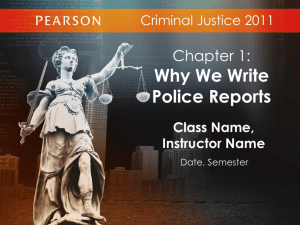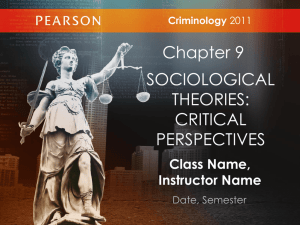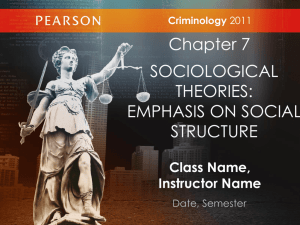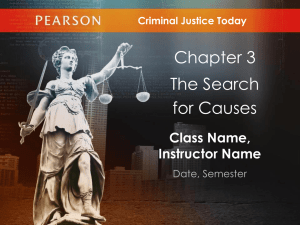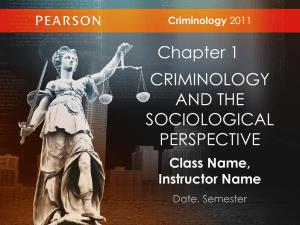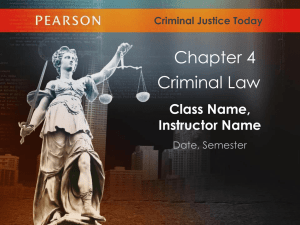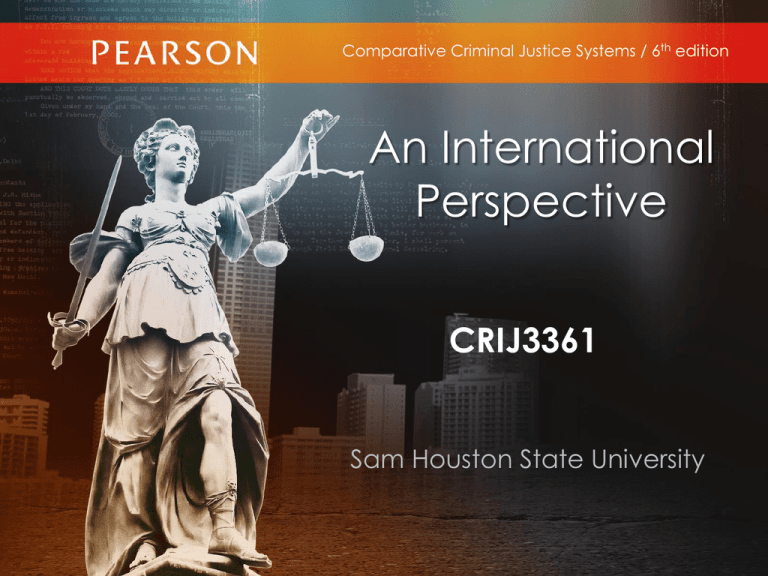
Comparative Criminal Justice Systems / 6th edition
An International
Perspective
CRIJ3361
Sam Houston State University
CHAPTER OBJECTIVES
1.1
Summarize the provincial and universal benefits of an
international perspective
1.2
Distinguish between, and give examples of, bilateral and
multinational cooperation
1.3
Describe and compare the historical, political, and descriptive
approaches to an international perspective
1.4
Distinguish, with examples, the functions/procedures and the
institutions/actors strategies
1.5
Summarize and distinguish the synthetic and authentic
classification strategies
© 2013 by Pearson Higher Education, Inc
Upper Saddle River, New Jersey 07458 • All Rights Reserved
Learning Objectives
After this lecture, you should be able to complete the following Learning Outcomes
1.1
Summarize the provincial and
universal benefits of an international
perspective
© 2013 by Pearson Higher Education, Inc
Upper Saddle River, New Jersey 07458 • All Rights Reserved
1.1
Benefits of an International
Perspective
Provincial
benefits
Universal
benefits
Provides a point of contrast
Use cross-national cooperation
to combat transnational crime
Provides ideas for system
improvement
Cross-national cooperation
can be either bilateral or
multinational
© 2013 by Pearson Higher Education, Inc
Upper Saddle River, New Jersey 07458 • All Rights Reserved
Learning Objectives
After this lecture, you should be able to complete the following Learning Outcomes
1.2
Distinguish between, and give
examples of, bilateral and
multinational cooperation
© 2013 by Pearson Higher Education, Inc
Upper Saddle River, New Jersey 07458 • All Rights Reserved
1.2
Bilateral Cooperation
Two countries, often neighbors, cooperate to fight
cross-border crime
Law enforcement cooperation
between the U.S. and Canada
includes a variety of
agreements and has been
described as broad, deep, and
highly productive
Cooperative efforts between
the U.S. and Mexico are
becoming more equitable and
effective
© 2013 by Pearson Higher Education, Inc
Upper Saddle River, New Jersey 07458 • All Rights Reserved
1.2
Multinational Cooperation
Many nations join in an effective cooperative effort
against transnational crime and criminals
The 27 countries of the
European Union have
agreements in the areas of
police and judicial cooperation
that provide good examples of
multinational cooperation
A goal is to create a European
judicial space that allows
Europeans to combat crime
and seek justice across borders
and throughout the continent
7
© 2013 by Pearson Higher Education, Inc
Upper Saddle River, New Jersey 07458 • All Rights Reserved
1.2
Examples of European Union Cooperation
Photos courtesy of Philip Reichel
8
© 2013 by Pearson Higher Education, Inc
Upper Saddle River, New Jersey 07458 • All Rights Reserved
Learning Objectives
After this lecture, you should be able to complete the following Learning Outcomes
1.3
Describe and compare the historical,
political, and descriptive approaches
to an international perspective
© 2013 by Pearson Higher Education, Inc
Upper Saddle River, New Jersey 07458 • All Rights Reserved
1.3
Approaches to an International
Perspective
Historical
This approach
provides
information
about past
successes and
failures and
prepares us for
change in the
future.
Political
This approach
helps one
understand how
politics affect a
nation’s justice
system and
interaction
among nations.
Descriptive
This approach
identifies the
main
components
and actors of a
criminal justice
system and
describes how
they are
supposed to
operate.
© 2013 by Pearson Higher Education, Inc
Upper Saddle River, New Jersey 07458 • All Rights Reserved
Learning Objectives
After this lecture, you should be able to complete the following Learning Outcomes
1.4
Distinguish, with examples, the
functions/procedures and the
institutions/actors strategies
© 2013 by Pearson Higher Education, Inc
Upper Saddle River, New Jersey 07458 • All Rights Reserved
1.4
Strategies under the Descriptive
Approach
Functions /
Procedures
Institutions /
Actors
With this strategy, the
emphasis is on understanding
the job to be done rather than
highlighting the position of the
person doing the job. An
example is the procedure
used for pretrial detention in
various countries.
With this strategy the focus is
on the operation of criminal
justice agencies and their
employees as a way to
identify similarities and
differences across countries.
An example is comparing the
way countries organize their
police force and the duties of
their police officers.
© 2013 by Pearson Higher Education, Inc
Upper Saddle River, New Jersey 07458 • All Rights Reserved
Learning Objectives
After this lecture, you should be able to complete the following Learning Outcomes
1.5
Summarize and distinguish the
synthetic and authentic classification
strategies
© 2013 by Pearson Higher Education, Inc
Upper Saddle River, New Jersey 07458 • All Rights Reserved
1.5
Classification Strategies
Synthetic
Strategy
Authentic
Strategy
When classification follows
this strategy one gets artificial
groups based on only a few
aspects of the object.
When classification follows
this strategy one gets natural
groups based on extensive
study of the object.
The result is a practical
classification that bring order
to diversity.
The result allows for prediction
regarding the group’s
members
© 2013 by Pearson Higher Education, Inc
Upper Saddle River, New Jersey 07458 • All Rights Reserved

